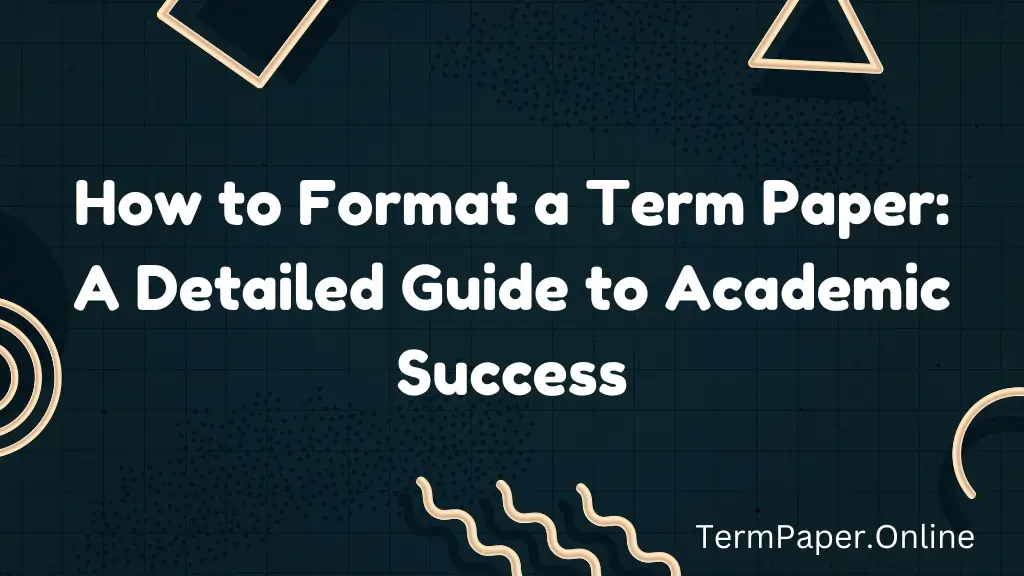
Table of Contents
- Introduction
- Understanding the Importance of Formatting
- Setting Up Your Document: Margins, Font, and Spacing
- Organizing Your Paper: Headings, Subheadings, and Page Numbers
- Citing Sources: In-Text Citations and Reference List
- Formatting the Title Page and Abstract
- Proofreading and Finalizing Your Paper
- Conclusion: Achieving Academic Excellence with Proper Formatting
Introduction
A crucial component of academic writing that frequently affects how tutors and peers view your work is formatting a term paper. Formatting your paper improves readability and professionalism while meeting academic standards. Following certain margins, spacing, font, header, and citation rules is part of proper formatting. This comprehensive term paper formatting guide will help you finish your assignment professionally and correctly.
Understanding the Importance of Formatting
Proper formatting is vital to the clarity, organization, and presentation of your thoughts in writing. To "write a term paper," follow formatting criteria to fulfill academic standards and make it easy to read. Students must adhere to precise formatting criteria, such as font size, line spacing, and margin settings, imposed by their instructors. Even if your paper is good, not following these standards can affect your grade.
Formatting also affects job credibility. A well-formatted term paper shows that you followed academic conventions and organized your ideas. Your meticulousness shows your work ethic and academic dedication. Also, appropriate formatting prevents misinterpretation of your ideas. Clear headers and subheadings help readers follow your argument and find relevant information in your paper. Whether you're doing it yourself or hiring someone to "write my term paper," formatting is essential for academic achievement.
Setting Up Your Document: Margins, Font, and Spacing
Before writing a term paper, formatting is vital. Most academic institutions have margin, typeface, and line spacing standards. One-inch margins are usually required on all sides. This provides adequate white space around the text for easy reading and instructor annotations.
Font size and type matter too. Most academic papers demand 12-point Times New Roman or Arial. This makes your paper legible and professional. Line spacing is also important in formatting. Most term papers require double-spacing, which gives teachers plenty of space to read and provide criticism. To guarantee your paper satisfies the criteria, review your instructor's or institution's guidelines when creating it.
Organizing Your Paper: Headings, Subheadings, and Page Numbers
Use headings, subheadings, and page numbers to organize your paper after setting up your document. Consistent headings organize your paper and assist readers through your ideas. Introduction, Literature Review, Methodology, Results, Discussion, and Conclusion are typical term paper sections. Each section should have a clear, APA, MLA, or Chicago-formatted heading.
Subheadings help readers follow your arguments and find relevant information in each section. Subheadings might help you organize themes in the Literature Review. Format your headings and subheadings consistently throughout your paper. Page numbers are also crucial to organizing. As for the first page of content, most academic papers require page numbers in the top right corner. Page numbers assist readers navigate your paper and are crucial to proper formatting.
Citing Sources: In-Text Citations and Reference List
In-text citations and reference list formatting are vital to academic writing. The text and reference list of your paper should follow different citation styles. APA style in-text citations include the author's last name and the year of publication, while MLA style includes the page number.
The Works Cited page, or reference list, should follow your citation style. Each entry should provide the author's name, work title, publishing date, and publication details to help readers find the source. Citation formatting errors can confuse and lower your work's credibility, so follow the standards. Whether hiring a "term paper writer service," or working alone, you must properly credit all sources and format the reference list in the acceptable style.
Formatting the Title Page and Abstract
Title pages, your term paper's first impression, need professional formatting. Title pages usually include your paper's title, name, course number, teacher, and submission date. Centre the title on the page and format it citation-style. Running heads, and brief titles at the beginning of each page, are required by APA.
Post your term paper abstract on a page after the title page. Abstracts are 150–250 words and summarize your paper's main results. Format the abstract in one paragraph using the required citation style. A solid first impression and academic paper compliance require a professional title page and abstract formatting.
Proofreading and Finalizing Your Paper
To avoid language, spelling, and formatting errors, proofread your term paper after formatting. Proofreading polishes your paper for submission and finds errors you missed while writing. When editing, check the formatting of headings, subheadings, citations, and the reference list.
You should also have someone else proofread your paper for errors. Whether you proofread yourself or hire a "term paper writer," academic writing requires careful editing. After checking your paper, make any necessary modifications and submit it per your instructor's directions.
Conclusion: Achieving Academic Excellence with Proper Formatting
A term paper requires precision and mastery of the guidelines to format. Using headers and subheadings, citing sources correctly, and proofreading your term paper can make it look professional and ready for submission. Good formatting promotes readability, credibility, and academic quality.
TermPaper.Online provides professional formatting and writing help to ensure your term paper reaches the highest standards. TermPaper.Online offers experienced help to "write my term paper" and format your paper to succeed academically.
